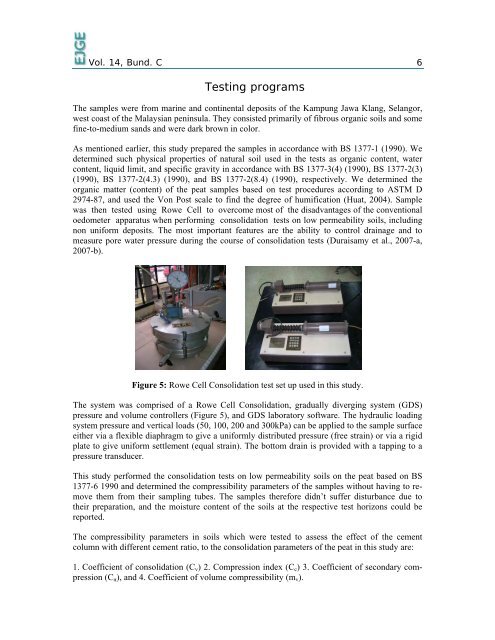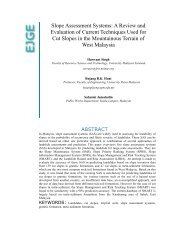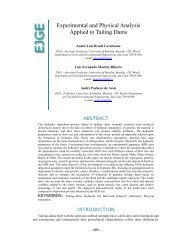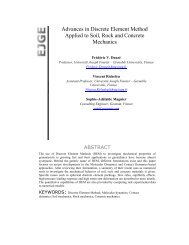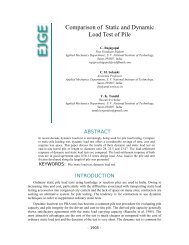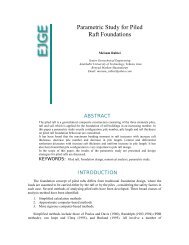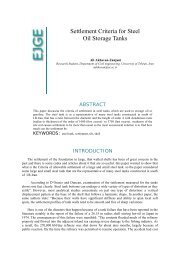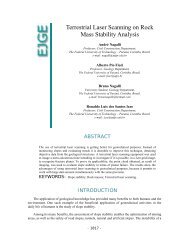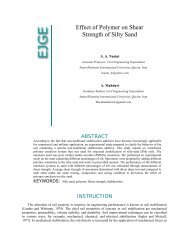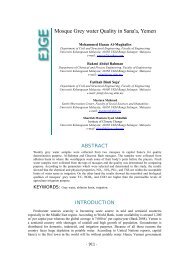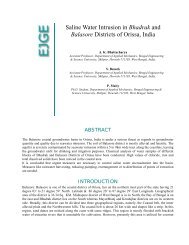Compressibility Characteristics of Fibrous Tropical Peat ... - Ejge.com
Compressibility Characteristics of Fibrous Tropical Peat ... - Ejge.com
Compressibility Characteristics of Fibrous Tropical Peat ... - Ejge.com
You also want an ePaper? Increase the reach of your titles
YUMPU automatically turns print PDFs into web optimized ePapers that Google loves.
Vol. 14, Bund. C 6<br />
Testing programs<br />
The samples were from marine and continental deposits <strong>of</strong> the Kampung Jawa Klang, Selangor,<br />
west coast <strong>of</strong> the Malaysian peninsula. They consisted primarily <strong>of</strong> fibrous organic soils and some<br />
fine-to-medium sands and were dark brown in color.<br />
As mentioned earlier, this study prepared the samples in accordance with BS 1377-1 (1990). We<br />
determined such physical properties <strong>of</strong> natural soil used in the tests as organic content, water<br />
content, liquid limit, and specific gravity in accordance with BS 1377-3(4) (1990), BS 1377-2(3)<br />
(1990), BS 1377-2(4.3) (1990), and BS 1377-2(8.4) (1990), respectively. We determined the<br />
organic matter (content) <strong>of</strong> the peat samples based on test procedures according to ASTM D<br />
2974-87, and used the Von Post scale to find the degree <strong>of</strong> humification (Huat, 2004). Sample<br />
was then tested using Rowe Cell to over<strong>com</strong>e most <strong>of</strong> the disadvantages <strong>of</strong> the conventional<br />
oedometer apparatus when performing consolidation tests on low permeability soils, including<br />
non uniform deposits. The most important features are the ability to control drainage and to<br />
measure pore water pressure during the course <strong>of</strong> consolidation tests (Duraisamy et al., 2007-a,<br />
2007-b).<br />
Figure 5: Rowe Cell Consolidation test set up used in this study.<br />
The system was <strong>com</strong>prised <strong>of</strong> a Rowe Cell Consolidation, gradually diverging system (GDS)<br />
pressure and volume controllers (Figure 5), and GDS laboratory s<strong>of</strong>tware. The hydraulic loading<br />
system pressure and vertical loads (50, 100, 200 and 300kPa) can be applied to the sample surface<br />
either via a flexible diaphragm to give a uniformly distributed pressure (free strain) or via a rigid<br />
plate to give uniform settlement (equal strain). The bottom drain is provided with a tapping to a<br />
pressure transducer.<br />
This study performed the consolidation tests on low permeability soils on the peat based on BS<br />
1377-6 1990 and determined the <strong>com</strong>pressibility parameters <strong>of</strong> the samples without having to remove<br />
them from their sampling tubes. The samples therefore didn’t suffer disturbance due to<br />
their preparation, and the moisture content <strong>of</strong> the soils at the respective test horizons could be<br />
reported.<br />
The <strong>com</strong>pressibility parameters in soils which were tested to assess the effect <strong>of</strong> the cement<br />
column with different cement ratio, to the consolidation parameters <strong>of</strong> the peat in this study are:<br />
1. Coefficient <strong>of</strong> consolidation (C v ) 2. Compression index (C c ) 3. Coefficient <strong>of</strong> secondary <strong>com</strong>pression<br />
(C α ), and 4. Coefficient <strong>of</strong> volume <strong>com</strong>pressibility (m v ).


